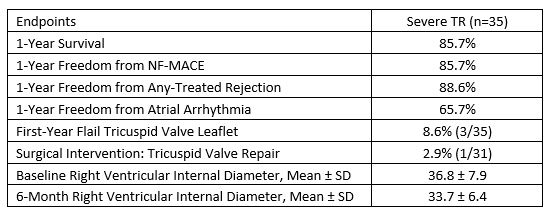Severe Tricuspid Regurgitation After Heart Transplantation: Does It Require Surgical Repair?
Cedars-Sinai Heart Institute, Los Angeles
Meeting: 2017 American Transplant Congress
Abstract number: C111
Keywords: Heart transplant patients, Heart/lung transplantation
Session Information
Session Name: Poster Session C: Hearts and VADS: All Topics
Session Type: Poster Session
Date: Monday, May 1, 2017
Session Time: 6:00pm-7:00pm
 Presentation Time: 6:00pm-7:00pm
Presentation Time: 6:00pm-7:00pm
Location: Hall D1
Background: Tricuspid regurgitation (TR) after heart transplantation is common. Causes for TR may be due to volume overload, flail tricuspid leaflet from endomyocardial biopsy, pulmonary hypertension, right ventricular dysfunction or due to inherent defect from the donor heart. It is not well established as to the natural history of severe TR following heart transplantation. We sought to assess our heart transplant patients who developed severe TR in the first month after heart transplantation for outcomes and the necessity for surgical intervention.
Methods: Between 2010 and 2014 we evaluated 35 heart transplant patients who had developed severe TR in the first month following heart transplant surgery. Outcomes included the development of right ventricular dysfunction, 2-year survival, freedom from Non-Fatal Major Adverse Cardiac Events (NFMACE: myocardial infarction, new congestive heart failure, percutaneous coronary intervention, implantable cardioverter defibrillator/pacemaker implant, stroke), atrial arrhythmias and any-treated rejection (ATR).
Results: Severe TR patients had improvement in their TR in the ensuing 3-6 months. There was also a numerical trend towards a decrease in mean right ventricular internal diameter by 3-months post-heart transplant (36.8 ± 7.9 to 34.6 ± 7.7, p=0.066) and a significant decrease by 6-months post-heart transplant (36.8 ± 7.9 to 33.7 ± 6.4, p=0.009). 1-year survival, freedom NF-MACE and ATR were 85.7%, 85.7%, 88.6%. Atrial arrhythmias were common (see table). There was indication of flail tricuspid valve leaflet in 3 patients within the first-year post-heart transplant. 1 patient did require tricuspid valve repair for severe TR, however, flail tricuspid valve leaflet was not reported in this patient. Conclusion: Heart transplant patients who develop severe TR following heart transplant surgery appear to show improvement in a majority of these valves over time. While patients who develop severe TR should be closely monitored, surgical intervention is rarely necessary.
Conclusion: Heart transplant patients who develop severe TR following heart transplant surgery appear to show improvement in a majority of these valves over time. While patients who develop severe TR should be closely monitored, surgical intervention is rarely necessary.
CITATION INFORMATION: Patel J, Kittleson M, Czer L, Aintablian T, Sharoff R, Levine R, Velleca A, Ramzy D, Esmailian F, Kobashigawa J. Severe Tricuspid Regurgitation After Heart Transplantation: Does It Require Surgical Repair? Am J Transplant. 2017;17 (suppl 3).
To cite this abstract in AMA style:
Patel J, Kittleson M, Czer L, Aintablian T, Sharoff R, Levine R, Velleca A, Ramzy D, Esmailian F, Kobashigawa J. Severe Tricuspid Regurgitation After Heart Transplantation: Does It Require Surgical Repair? [abstract]. Am J Transplant. 2017; 17 (suppl 3). https://atcmeetingabstracts.com/abstract/severe-tricuspid-regurgitation-after-heart-transplantation-does-it-require-surgical-repair/. Accessed December 20, 2025.« Back to 2017 American Transplant Congress
